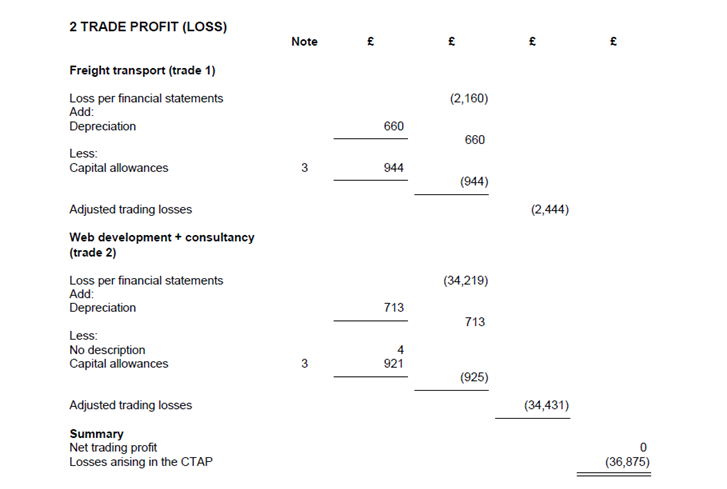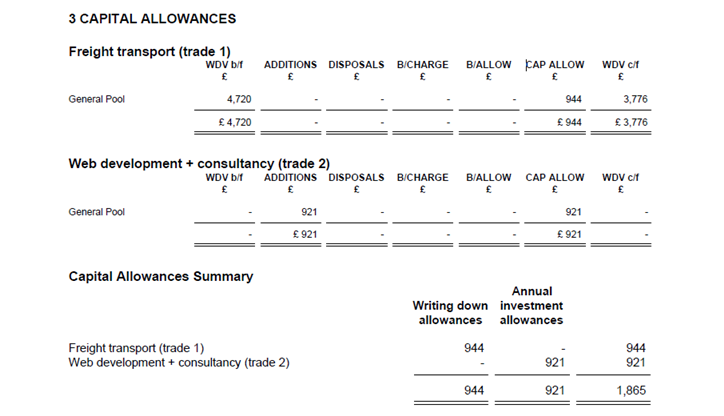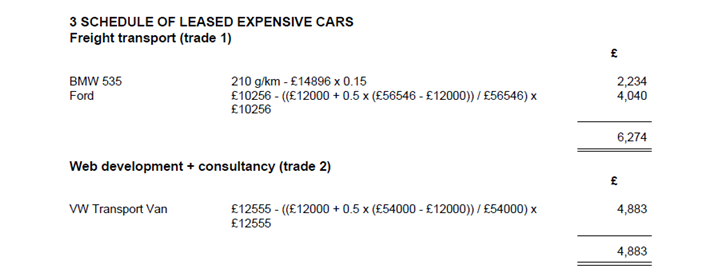 |
 |
This topic provides information on the Multiple Trades feature in IRIS Business Tax.
Click the links below to jump to a particular section:
Step 1 - Multiple Trade Maintenance
Step 2 - Business Tax Allocation
Step 3 - Business Tax – Trade Specific Data Entry
Step 4 - Business Tax – Corporation Tax Computation
Log onto IRIS Business Tax and select the Client.
From the menu bar select Edit
| Multiple Trades | Trade Maintenance
The Multiple Trade Maintenance
screen shows which trades are linked to the selected company. It displays
the names, their identifiers and the trading start and end dates.
Click New.

Trade ID – enter the unique identifier for the Trade.
Account Order – enter the Trade
order number, this is a mandatory field.
The order number will allow you to:
Allocate legacy data to a specific trade.
Specify
the order in which the trade is to appear on the enhanced corporation
tax computation report.
If the trade is allocated order ‘1’ you will have the option to allocate the legacy Business Tax data to this trade. This includes postings, trade losses, as well as leased expensive car data. The pool data for the capital allowances will always be allocated to the Trade with order ‘1’.
Trade Name – enter the name of the trade that is to be shown on the enhanced corporation tax computation report.
Start Date – enter the start date for the trade. The start date must be on or after the incorporated date for the company.
End Date – enter the trade cessation
date.
If the trade cessation date is valid for the current CTAP any trade losses will be unavailable to carry forward.
Any balancing allowance due in the general pool for the trade will also be automatically calculated.
If the trade is no longer trading in the selected CTAP, the trade will not be available to select in the Trade Name selection field.
This process is irreversible. If there are no data/postings allocated to the specified trade, the specific trade will be deleted without any further warning. However if there are any data/postings detected the Multiple Trades – Delete dialog displays.
Click OK.
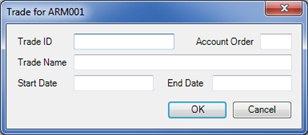
The following screen displays where Account
Order is '1'.
Click Yes to allocate
the legacy data to the specified trade or No
to cancel.

Delete – Allows the deletion of a Trade.
This process is irreversible. If there are no data/postings allocated to the specified trade, the specific trade will be deleted without any further warning.
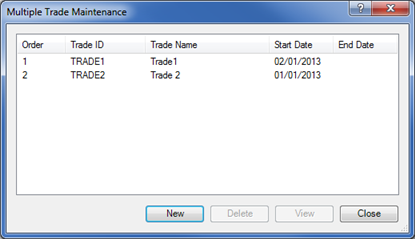
However if there are any data/postings detected the following dialog displays.
Click Details for a summary of the data/postings that must either be allocated to another trade or where appropriate must be deleted.
Click close.

The Business Tax Allocation option is only enabled if there are at least two active multiple trades setup in the Multiple Trade Maintenance screen.
Business Tax will validate if the postings from Accounts Production have been allocated in full within the Business Tax Allocation data screen. If there are any amounts unallocated the menu options will be disabled:
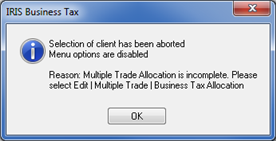
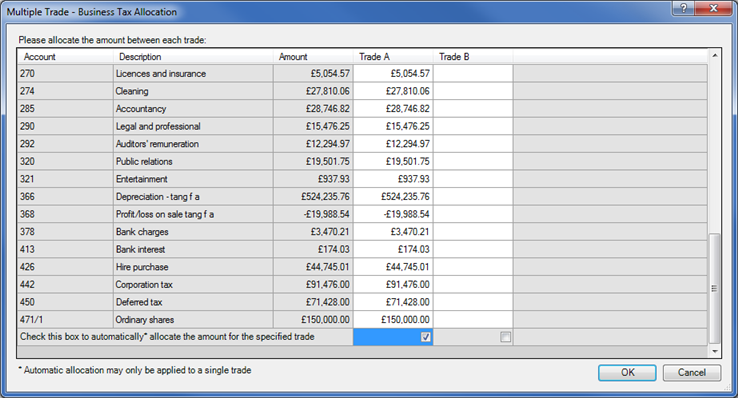
It is possible to automatically allocate the balance of each account that has not been allocated in full to another trade by selecting the Automatic allocation may only be applied to a single trade option (use the scroll bar to navigate to the last item).
By deselecting the option to automatically
allocate the amount, the following dialog displays, allowing you to reset
the trade allocation amount back to zero.
Click Yes
to restore any amounts for the trade (manual/automatic allocation
entries), back to zero.
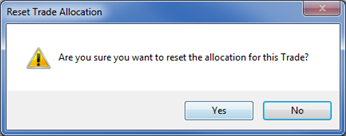
When the user clicks OK
to the Business Tax Allocation
data screen, additional validation will be carried out to ensure that
the amount(s) have been allocated in full. Where entries are detected
that have not been allocated in full, the following screen displays:
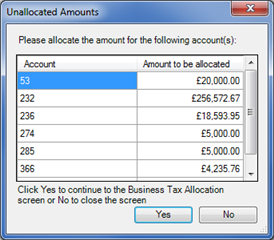
The amount(s) in the Unallocated
Amounts window must be allocated in full before Business Tax will
allow you to continue. If you select No
and close the Unallocated Amounts window, the remaining Business Tax
options will be disabled until the amount(s) have been allocated in
full.
The multiple trades feature in Business Tax will be fully enabled once the allocation between the trades has been completed.
If working on an existing IRIS database client it is likely that there will be some legacy data. This legacy data may have been allocated to the trade with ‘Account order 1’ setup in the Trade Maintenance window otherwise any brought forward balances must be manually entered/allocated into Business Tax.
Where trade adjustments are required
to be made in Business Tax, the data screens have been updated to
allow the specific tax adjustment to be made against the specific
trade. Full details of the trade specific adjustments can be found
below:
The posting option is used to adjust the
Corporation Tax computation.
How the posting adjusts the computation depends on the posting type and
whether it is specific to a trade.
As part of the multiple trades feature, trade specific entries may be made
for the following posting types:
Disallowed Expense Accounts
Trade Income Disallowed
Trade Expenses Disallowed
Trade Expenses Allowable
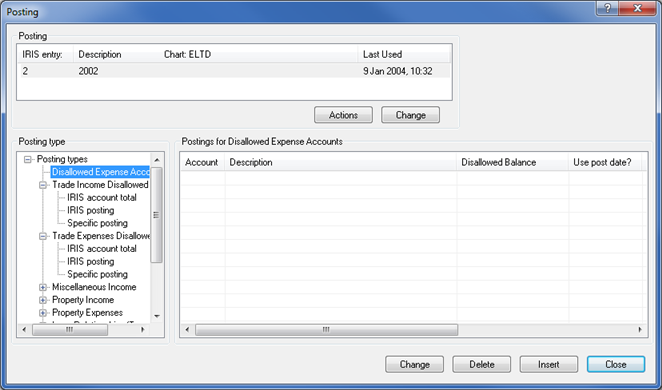
The following options are available:
IRIS
account total - this option allows you to select a specific account
from the trial balance and allocate this to a specific trade:
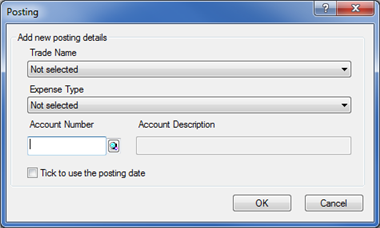
IRIS posting - this option allows you to specify a particular posting
to be disallowed and allocate this to a specific trade:
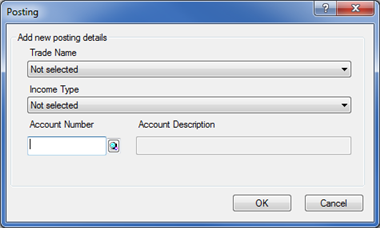
Specific posting – this option
allows you to enter freeform amounts for the specific trade:

To access this screen select Edit | Posting and highlight Directors' Remuneration.
To enter
further details regarding an individual director's remuneration highlight
the director in question and click Change.
The remuneration allocated to each director is calculated using the
amounts that have been allocated to each trade in the Multiple
Trade – Business Tax Allocation data screen.
Where a director has a remuneration
adjustment for more than one trade, use the Trade
Name selection to enter details
in for the specified trade(s).
Enter the director's remuneration details and click OK.
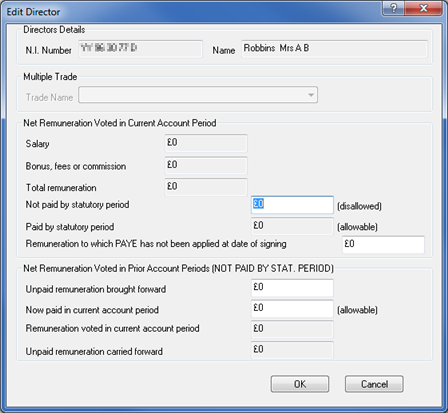
To access this screen select Edit | Losses
The Corporation Tax Losses screen allows you to review and amend Trade
specific losses for relevant corporation tax accounting periods (CTAPs).
To edit any Trade Loss value, click Edit Multiple Trade Losses.
In order to allocate any amount
as ‘Less Surrender to Group Relief’, select the Edit
option and complete the details in the Surrender
as Group Relief tab first, as this will enable the trade specific
‘Less unavailable to group’ fields.
Any amount(s) entered for the [Trade] will update the Company total
amounts in the main Corporation Tax Losses data screen. Additional
validation is also in place to ensure that the [Trade] specific loss
allocation is valid.
Click Edit
Multiple Trade Losses.

The following screen displays.
Use this screen to allocate the trade losses between each trade entity
for the specific CTAP.
Trading Profit / Loss - this will display the net profit / (loss) for each trade. The amount is automatically calculated by IRIS Business Tax.
Brought forward - the legacy trade brought forward losses may be allocated to a single trade; therefore it will be necessary to verify that the trade brought forward loss has been allocated to the correct trade(s). In future years, Business Tax completes this field when you run the Bring Forward option. Business Tax sets the [Trade] loss brought forward against the [Trade] Net Profit for the period.
Less utilised against trading income - Business Tax automatically completes this field for each [Trade] entity. The value calculated for the company is also shown in box 4 of the CT600.
Less utilised against other multiple trades income - there is no requirement that the loss from a trade [Trade A], needs to be set against the profits of another trade [Trade B]. However in practice, the company is likely to have the loss from one trade, set off against the profits of another trade. The amount that is allocated between each of the trades must result in the company having a nil balance.
Less utilised against investment income - under certain circumstances trading losses for a [Trade] may be set against investment income in the period.
Losses arising in the CTAP - automatically calculated for each trade.
Brought back - when bringing back a [Trade] trading loss made in a future CTAP, utilising it in the current period for the same [Trade], enter the amount of the loss allowable for offset against this [Trade] field.
Less utilised against total profits - where the [Trade] has made a loss in the CTAP, enter the amount that is to be utilised.
Less loss carried back - where you carry back a [Trade] loss made in the current CTAP to an earlier CTAP, enter the [Trade] carry back amount in this field.
Less surrendered to group relief - the [Trade] field is only accessible if the Surrender as Group Relief tab has been completed in the Group and Consortium (CT600C) data screen. Enter the amount that is to be surrendered for each trade.
Less unavailable to carry forward - if there are [Trade] losses that are to be written off / or should not be carried forward enter the amount for the [Trade].
Amount to
carry forward – this value is automatically generated by Business
Tax for each [Trade].
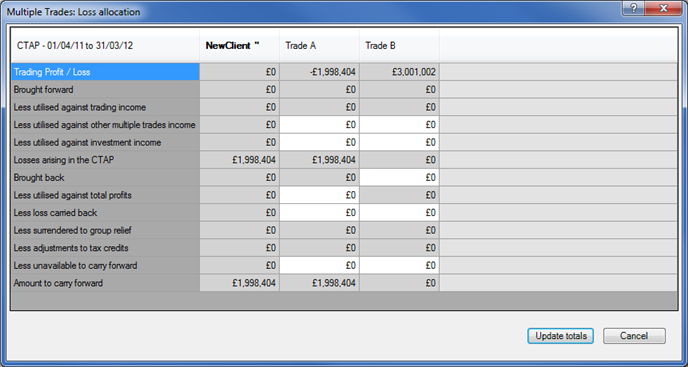
Trading Profit / Loss - displays the net profit / (loss) for each trade. The amount is automatically calculated by IRIS Business Tax.
Brought forward losses - all the entries in this section relate to the utilisation of the brought forward losses and there is an Edit button to access the losses brought forward as split into Pre and Post 01/04/2017.
Less utilised against trading income - Business Tax automatically completes this field for each [Trade] entity.
Less utilised against investment income - under certain circumstances trading losses for a [Trade] may be set against investment income in the period.
Less utilised against non-trading income – this is auto populated by the entries made per trade in the Losses Pre and Post 01/04/17 losses screen.
Less amount allocated to other trades – Losses incurred and brought forward Post 01/04/2017 can be offset against other trades. Select the Edit button in the Trade that has incurred the losses and enter the amount in the “Less amount allocated to other trades” row. The corresponding profit-making trade(s) taking the brought forward losses must have the amount entered in the trade allocation screen. The amount that is allocated between each of the trades must result in the company having a nil balance.
Less brought forward surrendered to group relief - the [Trade] field is only accessible if the Surrender as Group Relief tab has been completed in the Group and Consortium (CT600C) data screen for losses incurred post 01/04/2017 and brought forward. Enter the amount that is to be surrendered for each trade.
Current Year Losses - all the entries in this section relate to the utilisation of the current year losses.
To access this screen select Edit | Capital Allowances
This option is used to record assets which are eligible for capital
allowances and to calculate those allowances for each trade.
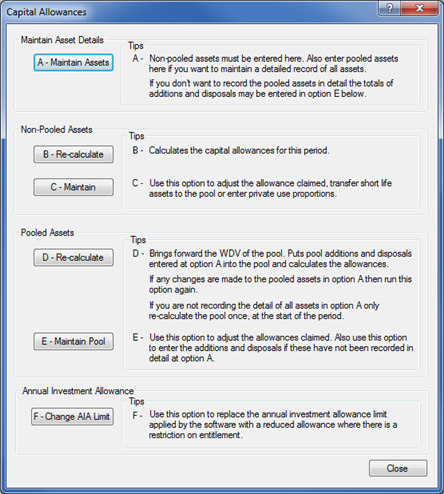
A - Maintain Assets
Each individual asset must be allocated to a specific trade. Select the Trade by clicking the drop-down option.
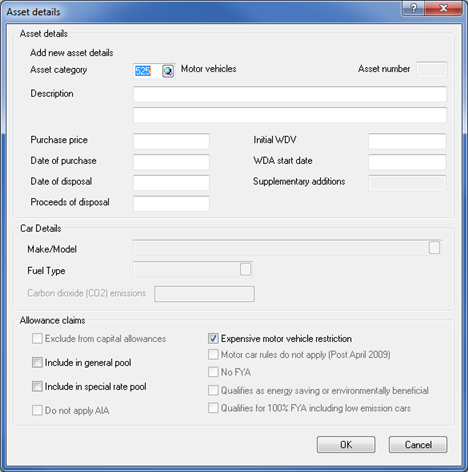
D - Recalculate
If this is the first year Business Tax
has been used, the following needs to be entered at the start of the accounting
period, for each trade:
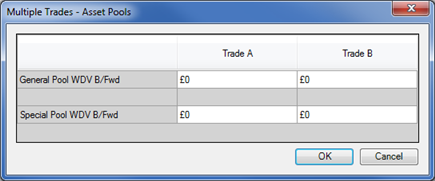
E - Maintain Pool
This option allows the user to select
the pool for the selected trade:
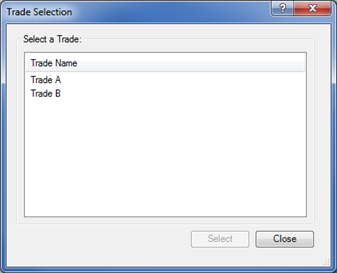
Highlight a Trade and click Select to view the Multiple
Trades - Maintain Asset Pools.
The following screen displays the pool data for the specified trade:
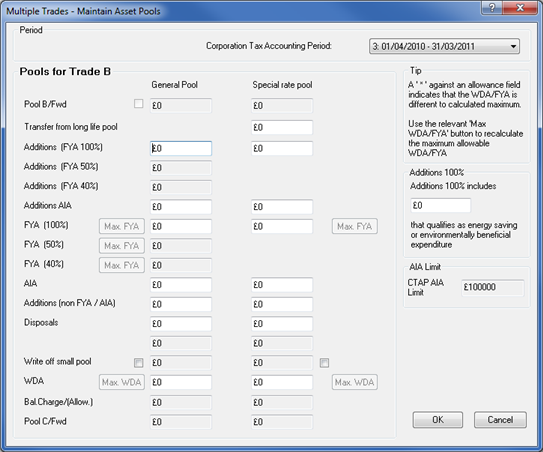
To access this screen select Edit | Building Allowances
This option is used to record assets which are eligible for buildings
allowances and to calculate those allowances for each trade.
Each individual asset must be allocated to a specific trade. Select the Trade by clicking the Trade Name drop-down option.
For the latest HMRC information relating
to Business Premises Renovation Allowance click here.

To access this screen select Edit | Leased expensive cars
Set up the leased car details for
each trade:
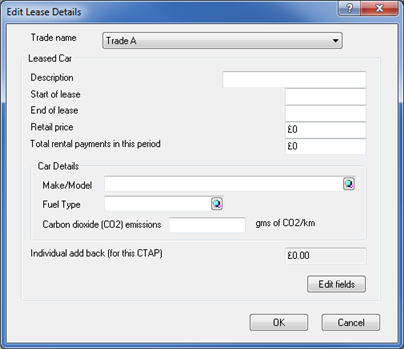
To access this screen select Edit | UITF40
Enter the total amount of the adjustment in the field provided for the company. The UITF 40 adjustment must then be allocated via the Business Tax Allocation screen for the appropriate trade(s).
To access this screen select Edit | Account Analysis
The Account Analysis option can be used to produce an additional report on the Corporation Tax Computation that displays detailed postings made in IRIS Accounts Production.
The report also details any automatic or manual trade specific posting adjustments that have been made for by the Postings option in IRIS Business Tax or by the Business Tax Accounts option.
Accounts Production Postings tab
This option displays all Profit and Loss Accounts for each active trade in the Limited Company that has relevant postings made to the account.
By selecting the check box next to the relevant account displayed on screen, IRIS Business Tax will produce a detailed journal of postings made in IRIS Accounts Production for the selected account(s) at the end of the corporation tax computation report.
To add/remove the journal(s) from the computation,
simply select the check box to include the selected account(s) in the
computation, or deselect the check box to remove the select account(s)
from the corporation tax computation report. By selecting or deselecting
the first check box on the title bar, IRIS Business Tax will include/remove
all the relevant accounts in the corporation tax computation.
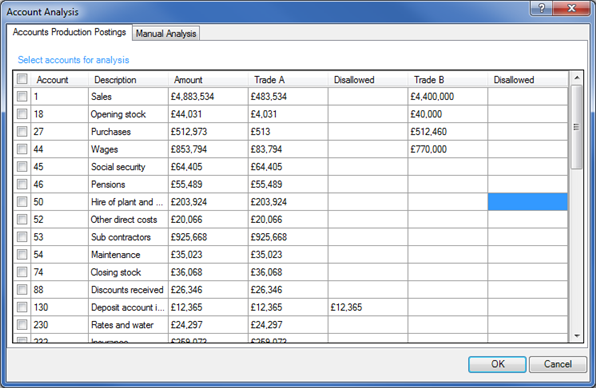
This option can be used to manually enter details for the Account Analysis report attached with the corporation tax computation:
Click New to create an account description that appears as a title in the Account Analysis report.
Click Delete to remove the account description and all manual postings made in that account.
When the appropriate account has been selected, the Trade must also be selected.
Enter the
narrative, amount and disallowed amount in the appropriate columns
as they will appear in the corporation tax computation report.

To access this screen select Data Entry | Enhanced Expenditure
Use this screen to enter the trade specific values for the enhanced expenditure section of the CT600 and any trade specific deduction for enhanced expenditure to appear on the corporation tax computation.
a) Select Show trade specific values to add / edit data for the selected trade.
b) Select
Show business totals to review the amounts that will be used on
the CT600.
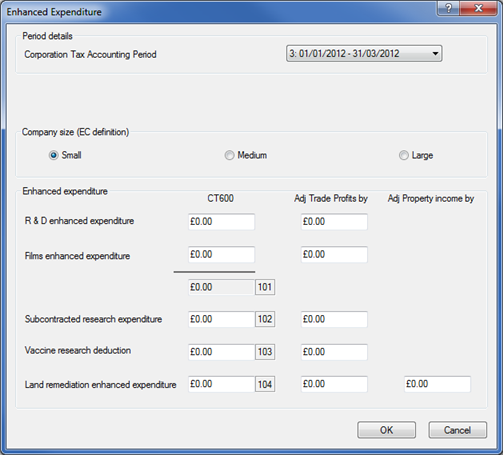
To access this screen select Edit | Update Profits
IRIS Accounts Production users - a warning message will display when accessing the Update Profits screen. If data is entered into this screen when there are already postings in Accounts Production, the data entered in Business Tax will be added to the ones already made in Accounts Production; giving incorrect figures.

Double-click to select each director
in the company to the Directors Remuneration:
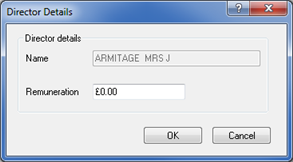
Select Edit
| Multiple Trades | Business Tax Allocation and allocate the
income / expenses for the appropriate trade(s):

The multiple trades feature is only compatible with the Enhanced corporation tax computation report.
To access this report select Reports | Corporation Tax | Enhanced.
If there are multiple CTAPs, select the CTAP
to be printed or check the box to group the CTAPs:
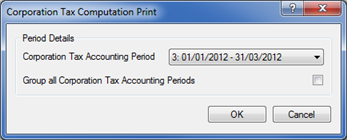
The report will detail each trade, in the following trade specific sections
of the computation.
